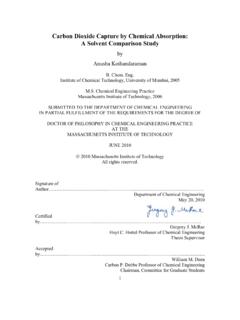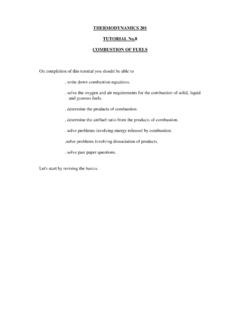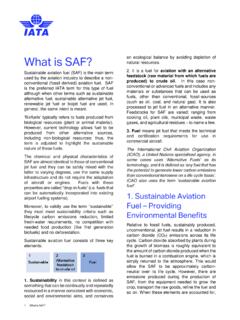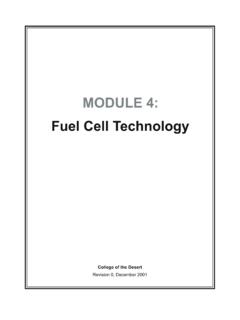Transcription of The Cost of Carbon Capture - Massachusetts Institute of ...
1 THE COST OF Carbon Capture . Jeremy David and Howard Herzog Massachusetts Institute of Technology (MIT), Cambridge, MA, USA. ABSTRACT. We have conducted a detailed analysis of costs associated with today's technology for CO2. separation and Capture at three types of power plants: integrated coal gasification combined cycles (IGCC), pulverized coal-fired simple cycles (PC), and natural gas-fired combined cycles (NGCC). The analysis was based on studies from the literature that analyzed the economics of capturing CO2 emitted at power plants. In this paper, we present a composite cost model and perform a sensitivity analysis to identify the cost-drivers for Capture .
2 We conclude that with new developments, CO2 Capture and sequestration can become a cost-effective mitigation pathway. INTRODUCTION. Fossil fuels currently supply over 85% of the world's energy needs and will remain in abundant supply well into the 21st century. They have been a major contributor to the high standard of living enjoyed by the industrialized world. However, their future is clouded because of the environmental and economic threat posed by possible climate change, commonly referred to as the greenhouse effect . The major greenhouse gas is Carbon dioxide (CO2 ) and the major source of anthropogenic CO2 is the combustion of fossil fuels.
3 If we can develop technology to Capture and sequester the fossil fuel CO2 in a cost-effective and environmentally sound manner, we will be able to enjoy the benefits of fossil fuel use throughout the next century. We have conducted a comparison of published studies from the past several years that analyzed the economics of capturing CO2 at Integrated coal Gasification Combined Cycle (IGCC) power plants (six studies), Pulverized Coal (PC) power plants (four studies), and Natural Gas Combined Cycle (NGCC) power plants (four studies). MEA scrubbing of flue gas was used to Capture the CO2 in the PC and NGCC plants, but IGCC plants allow the use of more energy efficient scrubbing processes involving physical absorption to Capture CO2 from the high pressure synthesis gas.
4 All studies were made using commercially available technology and include the cost of compressing the captured CO2 to about 100 atm for pipeline transportation. The results do not include cost of CO2 transportation and injection, which will add about $10/tonne of CO2 avoided. Initial results were presented at GHGT-4 (Herzog, 1999), while detailed results of this analysis are presented in David (2000). COMPOSITE COST MODEL OF CO2 Capture . Based on our analysis of the literature studies, we developed a composite cost model for CO2. Capture . The cost model developed uses six independent inputs, which were extracted from the literature studies we analyzed.
5 Three first inputs characterize the reference (no Capture ) plant: Capital cost, in $/kW;. Cost of electricity due to operation and maintenance, in mills/kWh;. Heat rate, in Btu/kWh, defined on the lower heating value (LHV) basis. We correlated the quantity of CO2 emitted (E), in kg/kWh, as a function of heat rate for a given type of power plant (IGCC, PC or NGCC). The second three inputs characterize the Capture plant: Incremental capital cost, in $/kg of CO2 processed per hour;. Incremental cost of electricity due to operation and maintenance, in mills/kg of CO2. processed;. Energy requirements of the Capture process, in kWh/kg of CO2 processed.
6 The Capture efficiency is usually about 90% in the studies reviewed. To compare the different types of Capture plants on a similar basis, the Capture efficiency needs to be kept constant. Consequently, we set the Capture efficiency at a constant value of 90%. The symmetry of the cost model inputs is shown in Table 1. The generation costs are normalized by the reference power plant output, while the Capture costs are normalized by the quantity of CO2. processed (which is directly related to the quantity and type of fuel burnt at the plant). These six parameters can be reasonably viewed as independent of each other.
7 The inputs from the literature studies we analyzed are averaged for each type of power plant to obtain the composite cost model inputs shown in Table 2. Table 1: Cost Model Inputs Reference Plant Capture Plant Capital Costs $/kW $/(kg of CO2 processed per hour). O&M Costs mills/kWh mills/kg of CO2 processed Energy Requirements Btu/kWh kWh/kg of CO2 processed It can be seen that NGCC power plants have the highest incremental capital cost and the highest energy requirements for the Capture ( kWh/kg of CO2 processed), due to the low content of CO2 in the flue gas (about 3%). Post- combustion decarbonization at PC plants is somewhat less energy intensive than at NGCC plants, kWh/kg of CO2 processed, because of the higher content of CO2 in the flue gas (about 13%).
8 Finally, the Carbon dioxide is in a concentrated flow under a fairly high pressure at IGCC plants, so these plants have the lowest energy requirements ( kWh/kg of CO2 processed). Table 2 reports the costs obtained for each type of power generation. We found that Carbon dioxide Capture increases the busbar electricity cost (COE) from to /kWh at IGCC plants, from to /kWh at PC plants, and, finally, from to /kWh at NGCC plants. Today, reference PC plants are slightly less expensive than reference IGCC plants. However, IGCC plants will become more economical than PC plants if Carbon sequestration becomes necessary.
9 Natural gas is always more competitive than coal for both reference and Capture plants, assuming today's fuel prices remain constant. If gas prices rise relative to coal in the future, IGCC. Capture plants could then compete with NGCC Capture plants. Table 2: Cost Model for Capture Plants, in 2000 and 2012. Cycle IGCC IGCC PC PC NGCC NGCC. Data Description 2000 2012 2000 2012 2000 2012. Input Capital Cost, $/kW 1401 1145 1150 1095 542 525. O&M, mills/kWh Heat Rate (LHV), Btu/kWh 8081 7137 8277 8042 6201 5677. Incremental Capital Cost, 305 275 529 476 921 829. $/(kg/h). Incremental O&M, mills/kg Energy Requirements, kWh/kg Basis Yearly Operating Hours, hrs/yr 6570 6570 6570 6570 6570 6570.
10 Capital Charge Rate, %/yr 15 15 15 15 15 15. fuel Cost (LHV), $/MMBtu Capture Efficiency, % 90 90 90 90 90 90. Reference Plant CO2 Emitted, kg/kWh coe: CAPITAL, mills/kWh coe: fuel , mills/kWh coe: O&M, mills/kWh Cost of Electricity, /kWh Thermal Efficiency (LHV), % Capture Plant Relative Power Output, % Heat Rate (LHV), Btu/kWh 9462 7843 11037 9461 7131 6308. Capital Cost, $/kW 1909 1459 2090 1718 1013 894. CO2 Emitted, kg/kWh coe: CAPITAL, mills/kWh coe: fuel , mills/kWh coe: O&M, mills/kWh Cost of Electricity, /kWh Thermal Efficiency (LHV), % Comparison Incremental coe, /kWh Energy Penalty, % Mitigation Cost, Capture vs.





